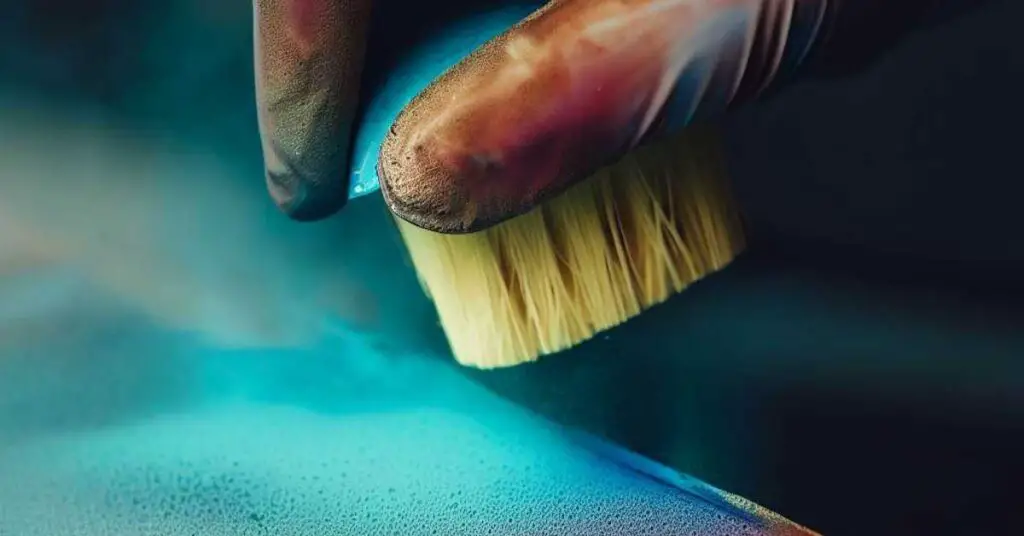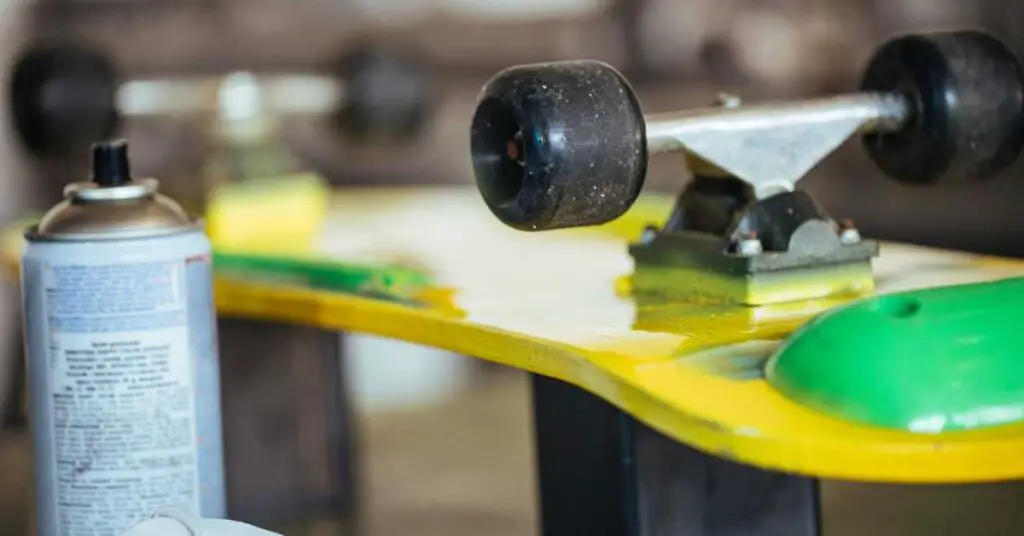As you look at the once pristine plastic surface, all you can see is the unsightly spray paint that has been carelessly splattered on it. The vibrant colors that once made you smile now make you cringe. You want to restore the plastic to its former glory, but the thought of removing spray paint from plastic is overwhelming.
Fear not, dear reader. With the right tools and techniques, you can remove spray paint from plastic without damaging the surface. Whether you’re a DIY enthusiast or a professional, the following tips and tricks will help you achieve a clean, paint-free plastic surface and give you a sense of belonging to a community of people who know how to tackle this challenge.
So, roll up your sleeves, put on your gloves, and let’s get started!

How To Remove Spray Paint From Plastic
Preparing Your Work Area
Before getting started, it’s important to prep your work area to ensure a successful outcome and avoid any mishaps.
Start by clearing clutter and ensuring proper ventilation in the workspace. Removing any items that could potentially hinder your movements and allowing fresh air to circulate will make the process smoother and safer.
Next, take safety measures seriously by wearing gloves, goggles, and a face mask to protect yourself from harmful chemicals and fumes. Choosing the right workspace is also crucial. Work on a stable, flat surface in a well-lit area to avoid any accidents.
Additionally, protect adjacent surfaces by covering them with plastic or old towels to avoid any accidental spillage or splatters.
By taking these steps, you can be well-prepared to tackle the task of removing spray paint from plastic surfaces.

Gathering the Necessary Tools
To get started, you’ll need some tools that are like a chef’s ingredients – you wouldn’t start cooking without them!
First, make sure you have plastic protection to cover any surrounding areas that may be affected by the removal process.
Next, consider your tool selection. Depending on the surface assessment, you may need a plastic scraper, sandpaper, or a paint stripper. It’s important to have all the necessary tools at hand to avoid any interruptions in the process.
In addition to tool selection, your workstation setup is key to successful removal. Have a clean and well-lit workspace with proper ventilation to avoid inhaling any chemicals.
Don’t forget to take safety precautions like wearing gloves and eye protection. And, just like a chef, it’s important to follow the recipe – in this case, the instructions for your chosen removal method – carefully.
With the right tools and setup, removing spray paint from plastic can be a breeze.
Using Soap and Water
Ready for a simple and effective way to wipe away unwanted color? Let’s dive into the power of soap and water for cleaning up a painted plastic surface!
First, gather your cleaning solutions, including warm water and dish soap. The temperature of the water is important as hot water can melt plastic and cold water is not as effective in removing paint. Use a gentle dish soap that won’t damage the plastic surface.
Next, apply the soapy water to the painted surface and start scrubbing gently. Use a soft-bristled brush or a sponge to avoid damaging the plastic. Don’t scrub too hard as it can scratch the surface and leave marks.
Once the paint has been removed, rinse the surface with clean water and wipe it dry with a clean cloth. A fan or blow dryer can be used to speed up the drying process.
With soap and water, you can easily remove spray paint from plastic surfaces with minimal effort and cost!
Trying Rubbing Alcohol
Well, well, well, looks like we’re ready to tackle the next method in our quest to banish that pesky color from our plastic surfaces – rubbing alcohol, anyone?
Rubbing alcohol is a popular choice for DIYers who want to remove paint from plastic as it’s a potent solvent that can break down the bond between paint and plastic.
Here are some benefits of using rubbing alcohol, along with some safety precautions to keep in mind:
Benefits of rubbing alcohol:
- Removes paint without damaging plastic
- Dries quickly, making it a fast and efficient method
- Can be used on a variety of plastic surfaces
- Readily available in most households
Safety precautions when using rubbing alcohol:
- Wear gloves and a face mask to avoid skin and respiratory irritation
- Use in a well-ventilated area
- Do not mix with other chemicals or solvents
- Keep away from heat and flames
Alternative uses for rubbing alcohol:
- Cleaning electronic devices
- Disinfecting surfaces
- Removing adhesive residue
- Cleaning jewelry
How to properly dispose of rubbing alcohol:
- Check with your local waste management facility for guidelines
- Do not pour down the drain or flush down the toilet
- Store in a cool, dry place away from direct sunlight
Comparing rubbing alcohol to other household remedies, it’s important to note that rubbing alcohol is stronger than dish soap and warm water but less harsh than nail polish remover or acetone.
It’s also less expensive than commercial chemicals like denatured alcohol or lacquer thinner.
Keep these factors in mind when deciding which method to use for removing spray paint from plastic, and always prioritize safety.
Applying Nail Polish Remover
You’re probably wondering what else you can do to get rid of that stubborn color on your plastic surface, and one solution you might want to try is applying nail polish remover.
Nail polish alternatives can be expensive and not as effective, but nail polish remover is a tried and tested method of removing stubborn stains from plastic surfaces.
However, it’s important to take safety precautions when using this method.
Before you start, make sure to wear gloves and work in a well-ventilated area.
Apply the nail polish remover to a cotton ball or cloth and gently rub it on the painted area.
Be careful not to rub too hard, as this can damage the plastic.
If the paint starts to come off, continue rubbing until all the paint is removed.
If the paint doesn’t come off easily, try using a plastic scraper to help lift it off.
Once the paint is removed, be sure to clean the area with natural cleaning methods like warm water and dish soap to prevent future paint mishaps.
Using a Magic Eraser
If you’re worried about damaging your plastic surface, don’t worry – using a Magic Eraser is a safe and effective method for getting rid of unwanted marks.
Here’s how to use it:
- Pre-cleaning steps: Before using a Magic Eraser, make sure to clean the plastic surface thoroughly with warm water and soap. This will help remove any loose debris or dirt that may scratch the surface during the erasing process.
- Using an eraser: Wet the Magic Eraser and gently rub it over the spray-painted area. Apply pressure as needed, but be careful not to scrub too hard, as this may cause damage to the plastic. Keep erasing until all the paint is removed.
- Alternative methods: If the Magic Eraser doesn’t work, try using rubbing alcohol or acetone. Apply a small amount of the solvent onto a cloth and gently rub it onto the paint until it comes off. Avoid using harsh chemicals or abrasive materials, as these can damage the plastic surface.
- Preventive measures: To prevent future spray-paint mishaps, consider covering the plastic surface with a protective covering or using painter’s tape to create a barrier around the area you don’t want painted.
- Safety precautions: Always wear gloves and work in a well-ventilated area when using solvents like rubbing alcohol or acetone. Keep them away from open flames or sparks, as they’re flammable.
Applying Acetone
Using acetone is a quick and effective method for getting rid of unwanted marks on plastic surfaces, but it’s important to use it carefully to avoid damaging the plastic.
Before using acetone, make sure to take safety precautions such as wearing gloves and working in a well-ventilated area. Acetone can be harsh on the skin and can cause respiratory issues if inhaled in large amounts.
It’s also important to properly dispose of the used acetone to avoid environmental damage.
Keep in mind that not all plastic surfaces are created equal. Some plastics may be more sensitive to acetone or other solvents, so it’s important to test a small area first before applying it to the entire surface.
Time management is also key when using acetone. It’s best to work in small sections to avoid the acetone from evaporating too quickly and not having enough time to work its magic.
With proper care and attention, acetone can be a powerful tool for removing spray paint from plastic surfaces.

Trying Sandpaper
Now, let’s try using sandpaper to smooth out any rough spots left by the spray paint and give your plastic surface a polished finish.
Plastic sanding is an effective alternative method to chemical solvents, but it requires a bit of caution.
First, choose the right sandpaper type for your plastic surface. Use fine-grit sandpaper, around 220-240 grit, to avoid scratching or damaging the surface.
Second, practice sanding safety by wearing protective gloves and a face mask to avoid inhaling fine plastic dust.
Third, avoid common sanding mistakes like applying too much pressure, sanding in a circular motion, or sanding against the grain.
These mistakes can cause uneven sanding or damage the plastic surface.
Fourth, start sanding slowly and gently in one direction until the rough spots are removed and the surface is smooth.
Check your progress frequently to avoid over-sanding.
When you are finished, clean the surface with warm water and soap, and allow it to air dry.
Sanding can be a great option for those who want to avoid harsh chemicals or for those who don’t have access to commercial solvents.
With the right tools and technique, sanding can give your plastic surface a polished finish that looks brand new.
Make sure to be careful when using sandpaper (even fine grit) to not damage the surface of the plastic.
Using a Heat Gun
Let’s heat things up and try using a heat gun to smooth out any rough spots on your plastic surface and give it a polished finish.
Before getting started, it’s important to review heat gun safety tips. Always wear protective gear such as gloves, goggles, and a mask to prevent inhalation of fumes. Keep a fire extinguisher close by in case of emergencies. Make sure the heat gun is unplugged and turned off when not in use.
Now that we’ve covered heat gun safety, let’s talk about heat gun alternatives. If you don’t have a heat gun, you can still achieve similar results with a hair dryer set on high. Just be aware that it may take longer to achieve the desired results.
The basic idea of using a heat gun or hair dryer to remove spray paint from plastic is that the heat source will heat up the spray paint and make it easier to remove.
When using a heat gun, start with a low-temperature setting and gradually increase as needed. Use a back-and-forth motion and keep the heat gun moving to prevent overheating and damage to the plastic surface.
After use, clean the heat gun according to the manufacturer’s instructions to ensure proper maintenance. With these heat gun techniques, your plastic surface will be looking like new in no time.
Protecting Your Plastic Surfaces in the Future
Now that you’ve successfully removed spray paint from your plastic surfaces, it’s important to take steps to prevent future damage.
Here are some tips to protect your plastic surfaces in the future:
- Choose alternatives: Consider using alternative paint types, such as enamel or acrylic, that are less likely to adhere to plastic surfaces.
- Understanding plastic types: Different types of plastics have varying degrees of resistance to paint. Before painting, make sure to research the type of plastic you’re working with to determine the best approach.
- Protective coatings: Apply a protective coating, such as a clear acrylic spray or a plastic-safe sealant, to your plastic surfaces to provide an extra layer of protection against the paint.
- Proper storage: When storing plastic items, make sure to store them away from paint and other chemicals to prevent accidental spills or contact.
By following these tips, you can help prevent future damage to your plastic surfaces and keep them looking clean and pristine. Remember, taking preventative measures is key to maintaining the longevity of your plastic items.
Frequently Asked Questions
Can I use these methods to remove spray paint from all types of plastic surfaces?
Wondering if you can use the same methods to remove spray paint from different types of plastic surfaces? Well, it all depends on the plastic compatibility and surface preparation.
You need to determine the paint thickness and the time required to remove it before choosing a method. It’s crucial to test any method in an inconspicuous area first to prevent damage to the plastic surface.
After removing the paint, you must clean any residue left behind. With proper research and preparation, you can successfully remove spray paint from plastic surfaces without causing any damage.
What safety precautions should I take when using acetone or other chemical solvents?
When using acetone or other chemical solvents to remove paint, it’s crucial to take proper safety precautions.
First and foremost, ensure that you’re working in an area with proper ventilation to avoid inhaling harmful fumes.
Additionally, wear protective gear such as gloves and long sleeves to prevent skin contact with the solvent.
Eye protection is also recommended to avoid any splashes or sprays that may cause eye irritation or damage.
Finally, make sure to dispose of any used solvents or materials in a safe manner to prevent harm to the environment.
By taking these safety measures, you can effectively remove paint from plastic while keeping yourself and the environment safe.
Will using these methods damage the color or finish of my plastic surface?
Preserving the color and finish of your plastic surface is crucial when removing spray paint. To do so, start with surface prep tips like wiping it down with warm water and soap.
Consider paint compatibility before using chemicals like acetone or lacquer thinner as they may cause damage to certain plastics. Heat-based removal options like a heat gun can also be used, but be cautious as overheating can melt the plastic.
Abrasive methods like sanding should only be used as a last resort, while non-abrasive options like rubbing alcohol or vegetable oil are safer and gentler on the surface.
By following these techniques, you can successfully remove spray paint from your plastic surface without causing damage to its appearance.
How can I prevent spray paint from getting on my plastic surfaces in the future?
To prevent spray paint from getting on your plastic surfaces, there are several prevention tips you can follow.
First, use protective covers such as drop cloths or plastic sheeting to cover the surrounding area.
Next, ensure that the surface is properly prepared by cleaning it thoroughly before painting.
Additionally, masking techniques such as painter’s tape can be used to cover areas that should not be painted.
Finally, proper spraying techniques such as spraying at the recommended distance and using even strokes can help prevent overspray and ensure a smooth finish.
By following these tips, you can avoid the headache of removing spray paint from your plastic surfaces and ensure a professional-looking result.
Are there any eco-friendly or natural alternatives to the chemical solvents mentioned in this article?
Looking for eco-friendly options for removing spray paint from plastic? Instead of relying on chemical solvents, try some natural and chemical-free methods to get the job done.
Sustainable solutions include using vegetable oil or rubbing alcohol to soften and remove the paint. Environmentally safe alternatives also include using a heat gun or sandpaper to gently strip the paint without harsh chemicals.
With these methods, you can remove spray paint from plastic while also being conscious of the impact on the environment. Try out these natural alternatives for a more sustainable approach to DIY projects.
Conclusion
Now that you’ve learned how to remove spray paint from plastic, it’s time to put your new knowledge to the test. Remember to prepare your work area, gather the necessary tools, and start with the gentlest method first before moving on to stronger chemicals. Always wear gloves and work in a well-ventilated area to protect your health.
One example of how to use these tips is if you accidentally sprayed paint on your plastic patio furniture. You can start by wiping the surface with soap and water, then move on to rubbing alcohol if that doesn’t work.
If the paint is still stubborn, you can try using acetone or sandpaper. Once you’ve successfully removed the paint, consider using a protective coating to prevent future damage.
With the right tools and techniques, you can easily remove spray paint from plastic without damaging the surface.